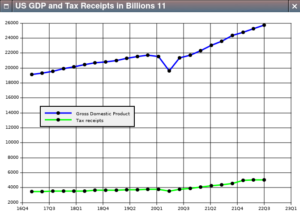I Collect puzzles and am the holder in due course of the family collection. My father stored this collection in a box made by my great grandfather.
I out grew the box years ago.
At one point I had a tangram puzzle. I’ve misplaced it so I made one.

As you can see trangrams are a collection of seven specific
shapes. There are:
– Two large triangles
– One medium triangle
– Two small triangles
– A Parallelogram
Their purpose is to arrange them in pleasing patterns.
For instance, here is a dragon

My purpose is not to show how they might be arranged, but rather how to make a set. Other on-line instructions I’ve read thinks about paper or card stock. I chose wood.
I went to a craft store for a craft board. I found an eight inch square of basswood, 1/8th of an inch thick, perfect for my purposes. The basswood is soft enough to cut with patience and a mat knife and strong enough to stand up to this use.
I found my cutting board in the kitchen (don’t tell Kate) and rooted around in my tool box for a triangle.

There is a six inch rule along the bottom leg and a flange on the other leg. Hold the flange along the edge of the cutting board to get either a right angle or a 45 degree angle.
Now we’re ready to layout our cuts.
1. Place the flange along the top of the board with the 45 degree leg going through the top left corner of the board. Draw that diagonal.
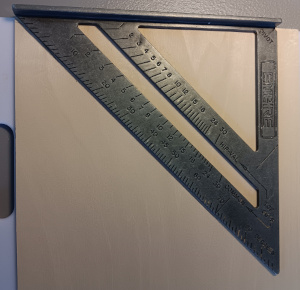
2. Measure along the side edge to the desired width. Mark that point The largest triangle will have this distance as the hypotenuse of their legs. I chose four inches.
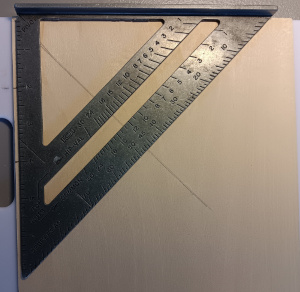
3. Mark the half way point. I calculated two inches.
4. Move the triangle so the the pivot point is at the desired width and the right angle leg goes across the board. Draw a line to the diagonal drawn in step one.

5. With the triangle flange along the top of the board, move triangle so that the right angle leg meets the intersection of the diagonal and bottom edge drawn in step four. You’ve now laid out a square which we will cut into tans (each piece of a tangram is called a
tan).
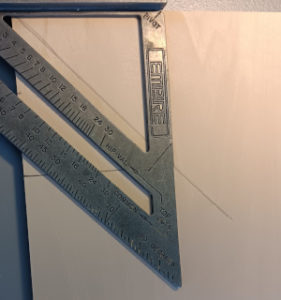
6. With the triangle flange along the side of the board move the the other point to the half-way mark. Draw a diagonal parallel to the first (and half its length) to the bottom of the
square. Confirm that it in fact crosses the bottom at the half-way point.

7. Get out your mat knife and cut out the square. I found that I had to score the wood using the right angle leg of the triangle to steady my blade. I kept running my knife through those scores until it broke through.
8. Draw a diagonal, perpendicular to the first through the top right corner. The line should go no than further the second, shorter, diagonal. You have now laid out the two large triangles and the one mid-sized triangle at the opposite corner. We will lay out
the other pieces in the band between the large triangles and the mid-sized.
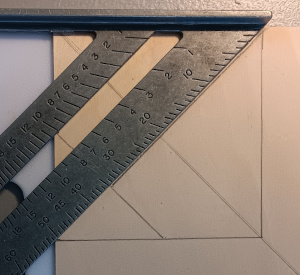
9. Place the triangle flange along the top of the board so that the right angle leg goes through the intersection of the second and third diagonals. Draw a line from the third diagonal to that point laying out the parallelogram and one small triangle.

10. Slide the triangle (with the flange along the side) so that hypotenuse leg meets the intersection of the second diagonal and the base. Draw a line from that point to the third diagonal laying out the square and the second small triangle.

Your layout should look like this:

Cut, in the following order:
– The first diagonal.
– The second (shortest) diagonal
– The third diagonal bisecting the largest piece into two large triangle.
– The third diagonal through that band yielding two quadrilaterals.
– The line between the parallelogram and a small triangle
– The line between the square and a small triangle
There are fourteen solid shapes that can be assembled using all the tans. A shape is solid if there are no lines between two points on its perimeter that cross an empty space.
I’ve read there are 9500 designs one can make using all seven pieces. All must lay flat.



